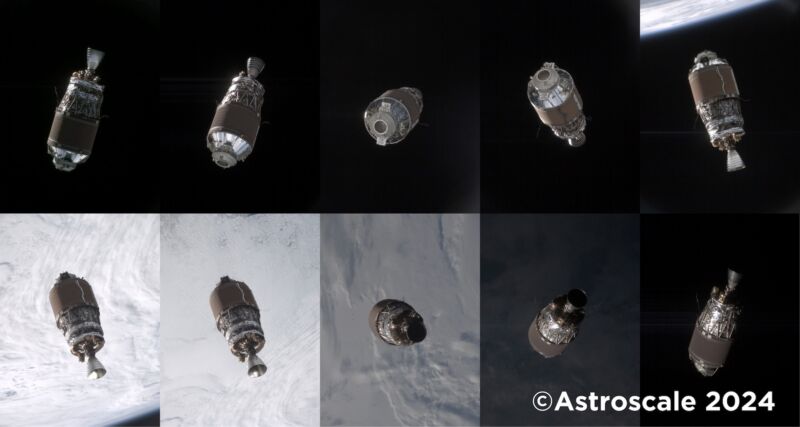
Enlarge / Astroscale’s ADRAS-J spacecraft captured these views of the H-IIA rocket upper stage on July 15.
There are more than 2,000 mostly intact dead rockets circling the Earth, but until this year, no one ever launched a satellite to go see what one looked like after many years of tumbling around the planet.
In February, a Japanese company named Astroscale sent a small satellite into low-Earth orbit on top of a Rocket Lab launcher. A couple of months later, Astroscale’s ADRAS-J (Active Debris Removal by Astroscale-Japan) spacecraft completed its pursuit of a Japanese rocket stuck in orbit for more than 15 years.
ADRAS-J photographed the upper stage of an H-IIA rocket from a range of several hundred meters and then backed away. This was the first publicly released image of space debris captured from another spacecraft using rendezvous and proximity operations.
Since then, Astroscale has pulled off more complex maneuvers around the H-IIA upper stage, which hasn’t been controlled since it deployed a Japanese climate research satellite in January 2009. Astroscale attempted to complete a 360-degree fly-around of the H-IIA rocket last month, but the spacecraft triggered an autonomous abort one-third through the maneuver after detecting an attitude anomaly.
ADRAS-J flew away from the H-IIA rocket for several weeks. After engineers determined the cause of the glitch that triggered the abort, ADRAS-J fired thrusters to approach the upper stage again this month. The ADRAS-J spacecraft is about the size of a kitchen oven, while the H-IIA rocket it’s visiting is nearly the size of a city bus.
Astroscale’s satellite completed two fly-around maneuvers of the H-IIA upper stage on July 15 and 16, examining all sides of the rocket as it soared more than 350 miles (560 kilometers) above the planet. Engineers also wanted to measure the upper stage’s spin rate and spin axis. At first glance, the upper stage appears remarkably similar to the way it looked when it launched. Despite exposure to the harsh conditions of space, the rocket’s outer skin remains covered in orange foam insulation, and the engine nozzle still shines as if it were new.
ADRAS-J autonomously maneuvered around the rocket at a distance of about 50 meters (164 feet), using navigation data from a light detection and ranging sensor and Astroscale’s custom-developed guidance algorithms to control its position as the vehicles moved around Earth at nearly 4.7 miles per second (7.6 kilometers per second). This is the crux of the challenge for ADRAS-J because the rocket is unpowered and unable to hold position. The upper stage also lacks laser reflectors and targets that would aid an approaching spacecraft.
This is a first
These types of complex maneuvers, known as rendezvous and proximity operations (RPO), are common for crew and cargo spacecraft around the International Space Station. Other commercial satellites have demonstrated formation-flying and even docking with a spacecraft that wasn’t designed to connect with another vehicle in orbit.
Military satellites from the United States, Russia, and China also have RPO capabilities, but as far as we know, these spacecraft have only maneuvered in ultra-close range around so-called “cooperative” objects designed to receive them. In 2003, the Air Force Research Laboratory launched a small satellite named XSS-10 to inspect the upper stage of a Delta II rocket in orbit, but it had a head start. XSS-10 maneuvered around the same rocket that deployed it, rather than pursuing a separate target.